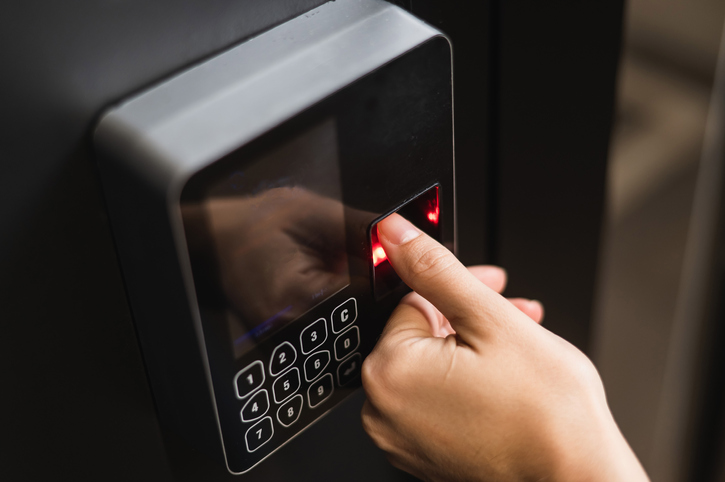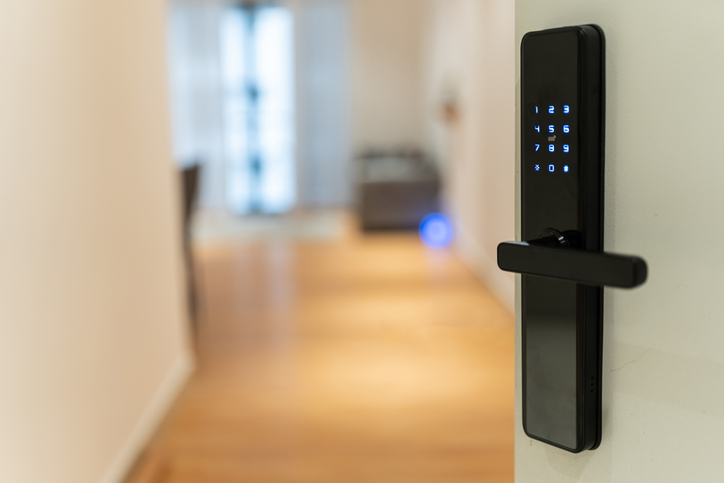Overview Of Keyless Entry Systems
Keyless entry systems are advanced security solutions that allow access to buildings, facilities, or vehicles without the need for traditional physical keys. Instead, these systems utilize electronic, digital, or biometric methods for authentication and access control. Keyless entry systems come in various forms, including keypad-based entry, key fobs, smart cards, and mobile-based access.

Keyless entry systems rely on digital authentication methods, which can include PIN codes, passwords, or cryptographic keys. Some keyless entry systems incorporate biometric identifiers, such as fingerprint, iris, or facial recognition, for highly secure and reliable access control. Many keyless entry systems offer an audit trail feature, recording access events, timestamps, and user identities, providing valuable data for security monitoring and analysis.
Key fobs and smart cards are commonly used in keyless entry systems, enabling users to unlock doors or access points with a simple tap or proximity to a reader. With advancements in technology, mobile-based access has become popular. Users can gain entry using their smartphones or wearable devices through Bluetooth or near-field communication (NFC) technology.
- Overview Of Keyless Entry Systems
- Keyless And Biometric Systems Cost
- Advantages Over Traditional Key-Based Systems
- Exploring Biometric Access Control
- Pros And Cons Compared To Keyless Systems
- Privacy Concerns And Securing Biometric Data
- Enhancing Security With Multi-Factor Authentication
- Overcoming Challenges And Limitations
- How To Prevent Data Breaches And Unauthorized Access
- Handling Emergency Situations And Power Outages For Continuous Security
- Dealing With Variations In Biometric Data Over Time
- Conclusion
Keyless And Biometric Systems Cost
The implementation costs of keyless and biometric access control systems are subject to various factors, with prices varying based on the scale and complexity of the installation. When budgeting for such systems, specific cost considerations must be taken into account. Hardware costs encompass the expenses for keyless entry devices, such as keypad locks or card readers, which can range from $50 to $200 per unit. Biometric readers, like fingerprint scanners or facial recognition cameras, may have price tags between $100 to $500 per unit, depending on the level of sophistication and technology.
Biometric technology costs can also vary widely. Basic fingerprint scanners for individual use may cost around $50 to $100 each, while more advanced commercial-grade readers can range from $200 to $1,000 per unit. For even more advanced biometrics, iris recognition systems are known for their high accuracy but come at a higher cost, typically between $1,000 to $3,000 per unit. Facial recognition systems, which have become increasingly popular, can cost between $500 to $1,500 per unit, with high-end models potentially exceeding $5,000.
Software and licensing fees are an essential part of the overall cost. Access control software ranges in price depending on the features and scalability, with basic packages starting around $500, while enterprise-level solutions may cost $2,000 to $10,000 or more. Licensing fees, dependent on the number of users or devices, can add an extra $20 to $100 per user/device.
Professional installation and integration are critical for the system’s successful deployment, but costs can vary significantly. Basic installations might start around $500, while larger and more complex setups can cost several thousand dollars. Integration with existing security infrastructure, such as surveillance systems or alarm panels, may incur additional costs, ranging from $500 to $2,000 or more.
To ensure continued system functionality and technical support, maintenance contracts are crucial. These contracts, covering regular system updates, troubleshooting, and technical assistance, generally range from 10% to 20% of the initial system cost per year. Organizations may also opt for 24/7 emergency support, incurring additional costs depending on the service provider.
Multi-factor authentication (MFA) significantly enhances security by requiring users to provide multiple forms of identification, such as biometric data and passwords, making it more challenging for attackers to gain unauthorized access to secure areas or sensitive information in Secure Entry Systems with Keyless and Biometric Access Control.
Advantages Over Traditional Key-Based Systems
Keyless entry systems offer several significant advantages over traditional key-based systems, making them an attractive choice for modern security needs. Keyless systems employ advanced authentication methods, such as biometrics or encryption, which are harder to duplicate or forge compared to physical keys, reducing the risk of unauthorized access.
Keyless entry systems eliminate the need to carry physical keys, providing users with greater convenience and ease of access. No more worries about lost or forgotten keys. Keyless systems often offer remote access management capabilities, enabling administrators to grant or revoke access permissions from anywhere, enhancing overall security and control.
Keyless systems can be integrated with multi-factor authentication, combining different methods like biometrics and PINs, further enhancing security levels. Over time, keyless entry systems can lead to cost savings compared to traditional key-based systems, as there is no need to rekey locks or replace lost keys regularly.
Integration With Existing Security Infrastructure
One of the key advantages of keyless entry systems is their seamless integration with existing security infrastructure. These systems can easily complement other security measures, such as surveillance cameras, alarm systems, and access control databases.
Keyless systems enhance the overall security of premises or facilities by providing an additional layer of protection that works in harmony with existing security measures. Integration allows centralized management of access control, enabling administrators to monitor and control access across multiple entry points from a single platform. Administrators can customize access permissions based on user roles and time schedules, improving security and efficiency.
Exploring Biometric Access Control
Biometric access control systems utilize unique physical or behavioral characteristics of individuals to verify their identity and grant access to secure areas. These systems offer a higher level of security and accuracy compared to traditional authentication methods. Biometric identifiers are difficult to replicate, making them a reliable means of access control. Some common biometric identifiers used in these systems include fingerprints, iris patterns, facial features, voice prints, and hand geometry.
Biometric access control systems are widely adopted in various industries, including government agencies, corporate offices, healthcare facilities, airports, and financial institutions, where security and access control are critical.
Commonly Used Biometric Authentication Methods
Fingerprint biometrics is one of the most widely used methods. The system captures the unique patterns on an individual’s fingertip and stores them as reference templates. When the user attempts to gain access, the system compares the presented fingerprint with the stored template for a match.
Iris biometrics relies on the unique patterns in an individual’s iris, which remains stable throughout their life. A specialized camera captures the intricate patterns, and sophisticated algorithms compare the live capture with the stored template.
Facial biometrics analyzes facial features like the distance between eyes, nose shape, and jawline to create a unique identifier. It can be used with images or video feeds to verify identity. Voice biometrics analyzes various vocal characteristics like pitch, tone, and speech patterns. A user’s voice is compared with an enrolled voiceprint to verify identity.
Hand geometry biometrics measures the size and shape of an individual’s hand. Users place their hand on a reader, and the system compares the captured measurements to enrolled data.
Pros And Cons Compared To Keyless Systems
While biometric access control systems offer undeniable advantages in terms of security, convenience, and administrative efficiency, organizations must carefully weigh the associated costs and potential drawbacks. By addressing privacy concerns and deploying robust security measures, biometric access control can prove to be a powerful and reliable solution for enhancing security in various industries and environments.
Benefits Of Keyless Systems
Biometric access control systems offer several advantages over traditional keyless systems, making them a preferred choice for organizations seeking enhanced security measures. One of the primary advantages is the high level of accuracy and security they provide. Biometric identifiers, such as fingerprints, iris patterns, and facial features, are unique to each individual, making it extremely difficult for unauthorized users to gain access. Unlike keyless systems that rely on PIN codes or passwords, which can be shared or stolen, biometric data is non-transferable and inherently tied to the individual, ensuring a robust and reliable authentication process.
Another significant advantage of biometric access control is the convenience and speed it offers to users. With biometrics, users don’t need to carry access cards or remember complex passwords, streamlining the authentication process and reducing the risk of forgotten or lost credentials. The quick and seamless nature of biometric authentication improves user experience and overall efficiency in accessing secured areas.
Biometric systems can significantly reduce administrative overhead related to access control management. As each user’s identity is directly linked to their unique biometric traits, there is no need for physical cards or keys, eliminating the costs and efforts associated with their distribution and management. Additionally, biometric systems can be seamlessly integrated with existing security infrastructure, providing centralized access control management and enhancing overall security measures.
Drawbacks Of Keyless Systems
It is essential to consider some drawbacks when opting for biometric access control systems. One of the primary concerns is the initial cost of implementation, which can be higher compared to traditional keyless systems. The cost includes acquiring specialized biometric sensors and deploying the necessary infrastructure for biometric data processing and storage. For larger installations or organizations looking to implement multiple biometric methods for redundancy, the overall cost can be a significant factor.
Biometric systems may be affected by environmental factors, potentially leading to temporary recognition issues. Variations in lighting conditions or the presence of dirt on sensors can impact accuracy. Additionally, physical changes in an individual’s biometric traits, such as cuts or injuries on a fingerprint, may momentarily hinder successful authentication.
Another critical aspect is the privacy concerns associated with biometric data usage. Since biometric identifiers are unique and highly sensitive to personal information, there may be hesitancy among users to provide such data without clear assurances of data protection. Organizations must address these concerns by implementing stringent data security measures and obtaining informed consent from users before collecting and using their biometric data.
Privacy Concerns And Securing Biometric Data
Addressing privacy concerns and ensuring the security of biometric data is paramount in the implementation of biometric access control systems. As biometric identifiers are unique and highly sensitive, organizations must take proactive measures to protect user privacy and prevent any potential misuse of data.
First and foremost, data encryption plays a crucial role in safeguarding biometric data. During transmission and storage, biometric data should be encrypted using strong cryptographic algorithms to prevent unauthorized access or tampering. Encryption ensures that even if data is intercepted, it remains unreadable and useless to malicious actors.
Anonymization and tokenization are additional privacy protection techniques. Wherever possible, organizations should anonymize or replace biometric data with tokens to eliminate direct associations with individuals. By doing so, even if the database is compromised, the data remains de-identified, reducing the risk of personal data exposure.
Obtaining informed consent from users is a fundamental ethical practice when collecting and using biometric data. Users must be fully informed about the purpose and usage of their biometric data, and their consent should be obtained explicitly. Transparent communication fosters trust between organizations and users, ensuring compliance with data protection regulations and ethical standards.
Data retention policies are essential in managing biometric data. Organizations should establish clear guidelines on how long biometric data will be stored. Retaining data for only as long as necessary and promptly deleting it when no longer needed minimizes the risk of data breaches and unauthorized access.
The secure storage of biometric data is crucial to prevent unauthorized access. Biometric data should be stored in highly secure databases with restricted access, limited only to authorized personnel responsible for managing access control systems.
In addition to technical measures, organizations should implement robust training programs for employees handling biometric data. Raising awareness about the importance of data privacy and security can help prevent inadvertent data leaks or mishandling.
Compliance with relevant data protection and privacy regulations, such as GDPR, HIPAA, or CCPA, is of utmost importance. Different jurisdictions and industries may have specific requirements for the collection, storage, and usage of biometric data. Organizations must ensure that their practices align with the legal frameworks in place to avoid potential legal liabilities.
Enhancing Security With Multi-Factor Authentication
Multi-Factor Authentication (MFA) is a security mechanism that requires users to provide two or more different forms of identification before granting access to a system or resource. The aim of MFA is to add multiple layers of security, making it significantly harder for unauthorized users to gain access, even if they manage to compromise one of the authentication factors. MFA is considered a vital component in modern access control systems, enhancing security by mitigating the risks associated with single-factor authentication methods, such as passwords or biometrics alone.
Combining Keyless Entry And Biometric Access With Other Authentication Methods
To maximize security and create a robust access control system, organizations can combine keyless entry and biometric access with other authentication methods as part of their MFA strategy. This approach ensures a higher level of protection while providing flexibility for users and administrators.
For instance, keyless entry systems can be integrated with a traditional password-based authentication method. When a user presents their key fob or uses a mobile app for entry, the system can prompt them to enter a password as an additional authentication factor. This combination ensures that even if an unauthorized individual gains possession of the key fob or smartphone, they still cannot proceed without knowing the correct password.
Another approach is to combine biometric authentication with a possession-based factor. For example, in addition to using fingerprint recognition, the user may also need to tap a smart card on a reader or use a mobile app as a secondary authentication step. This combination strengthens security by requiring both a unique biometric trait and physical possession of a key card or mobile device.
Organizations can implement time-based or location-based authentication factors. With time-based authentication, users are required to authenticate during specific time windows, adding an extra layer of control over access. Location-based authentication restricts access to designated geographic areas, ensuring that users can only access resources from authorized locations.
Mitigating Risks Of Unauthorized Access And Hacking Attempts
The implementation of multi-factor authentication (MFA) in keyless entry and biometric access control systems plays a vital role in mitigating the risks of unauthorized access and thwarting hacking attempts. By requiring users to provide multiple authentication factors, MFA significantly enhances security and reduces the vulnerability of relying solely on a single method for verification.
One of the key benefits of MFA is the protection it offers against stolen credentials. Even if an attacker manages to obtain one authentication factor, such as a password or key card, they would still need the additional factor(s) to gain entry. This added layer of security prevents unauthorized access in the event of compromised or stolen credentials.
MFA helps combat phishing attacks and social engineering tactics. Even if a user unintentionally divulges their password or other credentials to an attacker, the absence of the additional authentication factor(s) thwarts the attacker’s attempt to gain access.
Another significant advantage of MFA is its ability to strengthen weak passwords. By combining MFA with password-based authentication, organizations can compensate for the potential vulnerability of weak or easily guessable passwords. The additional factor ensures a higher level of security, even when passwords are not as robust as desired.
MFA also provides robust protection against credential stuffing attacks, where attackers use leaked username/password combinations from other breaches to gain unauthorized access. In such cases, even if the attacker possesses a valid username and password, they would still require the additional authentication factor to proceed, effectively preventing unauthorized entry.
Beyond its protective capabilities, MFA acts as a deterrent to potential attackers. The knowledge that they would need to bypass multiple authentication factors to gain access makes unauthorized entry attempts more challenging and time-consuming. This deterrence factor further strengthens overall security and discourages malicious actors from attempting unauthorized access.
Overcoming Challenges And Limitations
While keyless entry systems offer numerous benefits, they also present potential security risks that need to be addressed. One of the primary concerns is the vulnerability to hacking and unauthorized access attempts. Keyless entry systems that rely solely on digital authentication, such as PIN codes or passwords, may be susceptible to brute force attacks or password-cracking techniques.
To address these risks, organizations should implement measures such as rate limiting, which restricts the number of login attempts within a certain time frame. Additionally, encouraging the use of strong and unique passwords and regularly updating them can enhance security.
Another security risk is the possibility of keyless entry systems being susceptible to signal interception or cloning. Wireless keyless entry systems, particularly those using radio frequency (RF) or Bluetooth communication, may be at risk of signal interception by attackers. To mitigate this risk, organizations can employ encryption and rolling code technologies to ensure that transmitted data is secure and not susceptible to replication.
How To Prevent Data Breaches And Unauthorized Access
To prevent data breaches and unauthorized access in keyless entry and biometric access control systems, several strategies should be employed. First and foremost, organizations must prioritize user education and awareness. Users should be trained on best practices for access control, such as keeping credentials secure, not sharing passwords, and recognizing phishing attempts.
Implementing strong access control policies is crucial. This includes granting access privileges based on the principle of least privilege, ensuring that users only have access to the resources they require for their specific roles. Regularly reviewing and updating access permissions and conducting audits can help identify and rectify any potential vulnerabilities.
Continuous monitoring of access logs and suspicious activities can provide early detection of potential security breaches. Security analytics and anomaly detection systems can aid in identifying unusual access patterns, and alerting administrators to potential threats.
Handling Emergency Situations And Power Outages For Continuous Security
One of the challenges with keyless entry systems is ensuring continuous security during emergency situations or power outages. In the event of a power outage, backup power sources, such as uninterruptible power supply (UPS) systems, can be deployed to maintain system functionality.
For emergency situations, organizations should have contingency plans in place. This may include manual overrides or alternative access methods for critical areas in case the keyless entry system becomes temporarily inaccessible.
Integrating keyless entry systems with building alarm and monitoring systems can provide an additional layer of security during emergency events. This integration allows for centralized control and monitoring, ensuring that security personnel can quickly respond to critical situations.
Dealing With Variations In Biometric Data Over Time
Biometric access control systems may encounter variations in biometric data due to changes in an individual’s physical attributes over time. Factors such as aging, injuries, or medical conditions can lead to alterations in biometric traits, potentially affecting recognition accuracy.
To address this challenge, biometric systems should be designed with robust algorithms capable of accommodating variations in biometric data. Regular updates and re-enrollment of biometric templates can help the system adapt to changes in individuals’ biometric traits. Implementing liveness detection techniques can prevent spoofing attempts and ensure the biometric data being presented is from a live person rather than a static sample.
Continual research and development in biometric technology can lead to more advanced and adaptive systems that are better equipped to handle variations in biometric data over time, enhancing the reliability and effectiveness of biometric access control.
Conclusion
Secure entry systems integrating keyless and biometric access control represent cutting-edge solution that significantly enhances security across various domains. These advanced systems eliminate the reliance on traditional keys, introducing biometric authentication methods that offer heightened convenience, accuracy, and resistance to unauthorized access attempts. The incorporation of multi-factor authentication adds an extra layer of protection, strengthening overall security measures and mitigating potential breaches. However, to fully harness the benefits of these systems, organizations must address privacy concerns, implement robust security protocols, and conduct thorough cost-benefit analyses before adoption. By adopting a well-structured and proactive approach, secure entry systems with keyless and biometric access control can effectively fortify security, safeguard valuable assets, and deliver a seamless and secure user experience.




